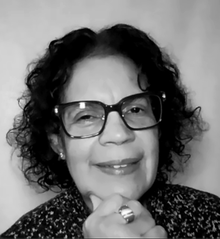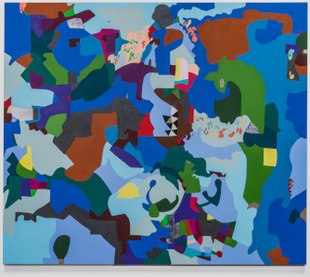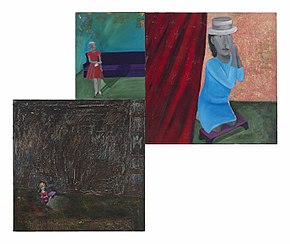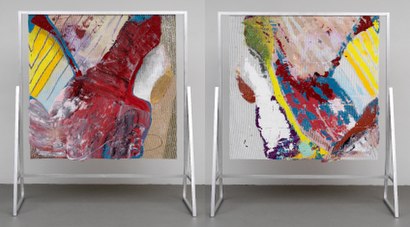| Candida Alvarez | |
|---|---|
 | |
| Born | 1955 Brooklyn, New York, US |
| Education | Yale School of Art, Skowhegan School of Painting and Sculpture, Fordham University |
| Known for | Painting, drawing, public art |
| Children | Ramon Alvarez-Smikle |
| Awards | US Latinx Artist Fellow, American Academy of Arts and Letters, Helen Frankenthaler, Joan Mitchell, Pollock-Krasner |
| Website | Candida Alvarez |

Candida Alvarez (born 1955) is an American artist and professor, known for her paintings and drawings.
Alvarez has exhibited at the Whitney Museum of American Art, MoMA PS1, Museum of Contemporary Art Chicago, and Contemporary Arts Museum Houston, Her work belongs to the public art collections of the Whitney, Art Institute of Chicago, San Jose Museum of Art, and Virginia Museum of Fine Arts, among others. She was named a 2022 US Latinx Artist Fellow and has been recognized by the Helen Frankenthaler Foundation, Joan Mitchell Foundation and Pollock-Krasner Foundation. She lives and works in Chicago and Baroda, Michigan and is a professor of painting and drawing at the School of the Art Institute of Chicago.
Education and career
Alvarez was born in 1955 in Brooklyn to parents who had arrived from Puerto Rico two years earlier. She grew up in a high-rise building in the Farragut Houses public housing project. Alvarez attended Fordham University at Lincoln Center in New York and received a BA in studio art/liberal arts in 1977; she studied at the Skowhegan School of Painting and Sculpture in 1981. In her early career in New York, she worked as a curator at El Museo del Barrio and exhibited in group shows at institutions including the Brooklyn Museum, MoMA PS1, Studio Museum in Harlem (artist residency) and Jamaica Arts Center. During that time, she had solo shows at Exit Art (1985), Queens Museum (1991), and Bronx Museum of the Arts (1992), among others.
In 1995, she enrolled at the Yale School of Art, studying with Mel Bochner, Rochelle Feinstein and Howardena Pindell. Her studies there set the stage for the playful form of abstraction for which she is known, and culminated in an MFA in 1997. The following year, she accepted a position at the School of the Art Institute of Chicago, where she is the F. H. Sellers Professor in Painting. In her later career, Alvarez has been included in major surveys of abstraction ("Magnetic Fields: Expanding American Abstraction, 1960s to Today," Kemper Museum of Contemporary Art, 2017) and Latinx art ("Estamos Bien – La Trienal 20/21," El Museo del Barrio, 2021; "Latinx Abstract," BRIC, 2021; "no existe un mundo poshuracán: Puerto Rican Art in the Wake of Hurricane Maria," Whitney Museum, 2022). She has had solo exhibitions at the Hyde Park Art Center (2012), Chicago Cultural Center (2017), GAVLAK Gallery (Palm Beach, 2019; Los Angeles, 2021) and Monique Meloche Gallery (Chicago, 2020), among other venues.
In 2017, six existing color works by Alvarez were adapted by Japanese fashion designer Rei Kawakubo for her "new camouflage" Comme des Garçons haute couture menswear collection.
Work and reception
Alvarez reworks both materials and methods in her work, resisting a single visual methodology and disrupting distinctions between abstraction, representation and conceptualism. Her painting synthesizes a wide array of modes: floating color fields, highly structured geometries, subdued figural portraits, text and invisible guiding systems. Critic Susan Snodgrass has described Alvarez’s process as syncretic and belonging "to a strategy of cultural fusion and hybridity that allows passage between different contexts and histories, as does her use of personal narratives and private symbols as markers of identity."

Early work
In the 1980s, Alvarez produced largely representational paintings that drew on her city experiences and Puerto Rican heritage, mixing portraiture, landscape, written words and personal iconography. She often portrayed family members; He loved to dream (1985) was a mixed-mode work of flat planes, sharp angles and relief imagery depicting her father. Paintings such as the three-panel, altar-piece-like work, Sit, Stand & Kneel (1986) or Soy Boricua (I am Puerto Rican) (1989) portrayed passive, dutiful, wary or increasingly powerful female protagonists as they navigated roles and identities. Critics characterized these color- and imagery-laden revelations of self and traditional family life as introspective, moody, emotionally charged and reminiscent of magic realism, naïve art or confessional poetry; Arts Magazine's Peggy Cyphers likened them to the art of Marc Chagall and Paul Klee.
In subsequent work, Alvarez experimented with new mixed-media materials, textures and multi-panel formats that functioned as both structural and narrative devices. Her solo exhibitions at the Bronx Museum of the Arts (1992) and New Britain Museum of American Art (1996) featured multi-image paintings of rudimentary human forms and abstract primal energies that evoked themes of organic or inner growth. New York Times critic Holland Cotter wrote that the " lyrical, painterly work" charted progress "from darkness to light and from fragmentation to wholeness," drawing strength from its ambiguity regarding the relationships between human figures and natural forces. The panels hinted at sequential, internal passages while also serving as external, quasi-architectural spaces, alluding to the 14th-floor housing-project windows she looked out of as a child (e.g., Sisters I and Sisters 2, 1992; Sixteen Stories, 1996). This work presaged her later interest in minimalist seriality and gestural abstraction.
Later work
During her time at Yale, Alvarez studied color theory and began experimenting with intuitive processes, puzzles and games, in part influenced by her friendship with the minimalist and conceptual artist Sol LeWitt. These strategies pushed her work toward abstraction and remixed its clearly autobiographical aspects, while maintaining its attention to process and inspirational roots. Paintings such as Tossing Pennies (1995), which incorporated pennies and colorful painted orbs as nodes in a connect-the-dots scheme, were determined by chance; in similarly vibrant and graphic works, she used letters and numbers as organizing systems (e.g., Louise or Jimmy, both 1996).
In the 2000s, Alvarez's work has been characterized by a decorative visuality and postmodern versatility that ranges across contemporary styles. Her TBA Exhibition Space show (2005) featured quirky, graffiti-like drawings and large fabric pieces evoking toys, keepsakes and personal history. Drawings such as Celia Mia (2000–1) juxtaposed floral and geometric patterns, text and playful characters, while the fabric works depicted such figures with bold black shapes and lines stitched in black embroidery floss on curtain-like squares of black cotton.
Alvarez's later exhibitions—"Mambomountain" (Hyde Park Art Center, 2012), "Here" (Chicago Cultural Center, 2017), "Estoy Bien" (Monique Meloche Gallery, 2020) and "Palimpsest" (GAVLAK Los Angeles, 2021)—have been more painting-focused. In monumental works such as mary in the sky with diamonds (2005), arroz amargo (2010) and hi ho silver (2008), she created shifting, layered surfaces packed with textures, ideas and scraps of pop culture. New City compared the billowing shapes, sinuous lines and snippets of text of the latter painting to "a cartoon that’s been chopped up in a blender." The "Here" retrospective presented nearly sixty works spanning forty years. The show was achronolgically arranged to create connections, and united by "camouflage" baseboard molding running throughout that derived from the work used in her Comme des Garçons collaboration. New works included subtle plays between inside and outside, felt and seen (e.g., Listening to Haruki Murakami while looking at a sunset, 2016) and whimsical challenges to the rigidity and authority of the modernist grid. Examples of the latter included Remembering Sol LeWitt (2016)—which combined a predictable checkerboard, a casually meandering web, gold glitter and scripted text—and the spatially disorienting Rainbows on my Studio Floor (2016), a receding, slightly askew pattern of saturated parallelograms based the exhibition space's tiled floor.

The "Estoy Bien" ("I'm fine") exhibition featured large, double-sided "Air Paintings" that employed multiple visual idioms and referenced loss (her father's recent death), seasonal cycles and the effects of climate change—in particular, Puerto Rico’s devastation by Hurricane Maria. The paintings were made of partly translucent PVC-mesh material and suspended from freestanding aluminum frames. She created them by printing collages of digitally manipulated images from her studio practice onto the mesh, which she then modified with gestural applications of latex ink, glitter and paint and painted fields of geometric and camouflage-like forms (e.g., Here to There, 2018).
The show's title painting, Estoy Bien, a vibrant, pastel-colored work featuring abstract splashes of coral, aqua blue and white paint, inspired the name and theme of El Museo del Barrio's first-ever national survey of contemporary Latino work—the largest in its history—"Estamos Bien — La Trienal 20/21." New York Times critic Holland Cotter described Alvarez's title as complex and "tinged with irony, the words suggest both resilience and bitterness"; the museum called it "a declaration of defiant resilience and a provocation, conflating a sarcastic and a positive tone." The exhibition (which included Alvarez) confronted systems of power and examined identity, structural racism, migration, displacement, climate and ecological justice through the work of 42 artists and collectives.
In the "Palimpsest" paintings (2021), Alvarez employed a similar process to her "Air Paintings," scanning and printing drawings—in this case, on one-sided canvases—then applying successive transparent layers that effaced and intermingled with the initial images, creating complex records of action and time.
Awards and recognition
In 2022, Alvarez was named a US Latinx Artist Fellow (Ford Foundation and Mellon Foundation) and received an Arts and Letters award in Art from the American Academy of Arts and Letters. She has also been recognized by the Helen Frankenthaler Foundation (2021), Joan Mitchell Foundation (2019), International Artists' Studio Program (Stockholm, 1999), Pollock-Krasner Foundation (1994), Mid-Atlantic-NEA Regional Fellowship (1988) and New York Foundation for the Arts (1986). She has been awarded artist residencies by the LUMA Foundation (Arles), MacDowell Colony, MoMA PS1, Pilchuck Glass School and the Studio Museum in Harlem.
Alvarez's work belongs to public art collections including the Addison Gallery of American Art, Art Institute of Chicago, Baltimore Museum of Art, Blanton Museum of Art, Brandywine Workshop and Archives, DePaul Art Museum, El Museo Del Barrio, Museum of Contemporary Art Chicago, Pérez Art Museum Miami, San Jose Museum of Art, Studio Museum in Harlem, Virginia Museum of Fine Arts, and Whitney Museum, among others. She has also received and completed three public art commissions. These include What do you See?, a set of six stained glass windows created for the P.S. 306 (public school) in the Bronx; the MTA Arts & Design project, B is for Birds in the Bronx (2006), faceted glass windscreens installed at the New York's Bronx Park East station; and Howlings—Soft Paintings (2017), a latex-on-PVC mural installed on the banks of the Chicago River as a part of Chicago's Year of Public Art.
References
- ^ Voon, Claire. "Chicago Legend Candida Alvarez Finds Comfort—and Reprieve from Trauma—in Abstraction," ARTnews, March 13, 2020. Retrieved October 10, 2022.
- ^ Snodgrass, Susan. "Arriving Here: Candida Alvarez," The Seen, Issue 05, 2017. Retrieved November 14, 2022.
- ^ Waxman, Lori. "Candida Alvarez, Up to Try Anything," Chicago Tribune, August 3, 2017. Retrieved November 14, 2022.
- ^ Whitney Museum of American Art. "no existe un mundo poshuracán: Puerto Rican Art in the Wake of Hurricane Maria," Exhibitions. Retrieved November 15, 2022.
- ^ Museum of Modern Art. Candida Alvarez, Artists. Retrieved November 14, 2022.
- Museum of Contemporary Art, Chicago. "The Long Dream," Exhibitions. Retrieved November 15, 2022.
- Glentzer, Molly. "'Outside the Lines' opens up a world of abstraction,' Houston Chronicle, November 8, 2013. Retrieved November 14, 2022.
- ^ Whitney Museum of American Art. Candida Alvarez, Collection. Retrieved November 14, 2022.
- ^ Art Institute of Chicago. Mary in the Sky With Diamonds, Candida Alvarez, Artworks. Retrieved November 14, 2022.
- ^ San Jose Museum of Art. "Evergreen: Art from the Collection," Exhibitions. Retrieved November 15, 2022.
- ^ Virginia Museum of Fine Arts. Chill, Candida Alvarez, Collection. Retrieved November 14, 2022.
- ^ Velie, Elaine. "15 Latinx Artist Fellows Receive $50K Grants," Hyperallergic, May 15, 2022. Retrieved November 14, 2022.
- ^ Foundation for Contemporary Arts. Candida Alvarez, Recipients. Retrieved November 14, 2022.
- ^ Joan Mitchell Foundation. Candida Alvarez, Supported Artists. Retrieved November 14, 2022.
- ^ Pollock-Krasner Foundation. Candida Alvarez, Artists. Retrieved November 14, 2022.
- ^ "Candida Alvarez – SAIC Faculty Sabbatical Exhibit". Retrieved 2024-10-14.
- ^ Barbara A. MacAdam, "Candida Alvarez, Myth, Memory and Old Lace," ARTnews, February 1993, p. 67.
- ^ Jones, Kellie. "When Painting Stepped Out to Lunch," Candida Alvarez: Here. A Visual Reader, Chicago: The Green Lantern Press. Retrieved November 15, 2022.
- ^ Foumberg, Jason. "Candida’s Coloring Book," Chicago Magazine, May 2017, p. 43.
- ^ Quiles, Daniel R. "Numbers and Dreams: Candida Alvarez, 1976–1988," Candida Alvarez: Here. A Visual Reader, Chicago: The Green Lantern Press. Retrieved November 15, 2022.
- Brooklyn Museum. "Recollections: Works on Paper by Candida Alvarez & Vincent D. Smith," Exhibitions. Retrieved November 14, 2022.
- ^ Brenson, Michael. "New Visions at Soho20 Gallery," The New York Times, January 9, 1987. Retrieved November 14, 2022.
- Queens Museum. History. Retrieved November 14, 2022.
- ^ Zimmer, William. "Echoes of Paris in a Montevideo School," The New York Times, January 3, 1993. Retrieved November 14, 2022.
- ^ Myers, Terry R. "Recognize," Candida Alvarez: Here. A Visual Reader, Chicago: The Green Lantern Press. Retrieved November 15, 2022.
- ^ Leahy, Brian T. (2020-05-01). "Candida Alvarez". Artforum. Retrieved 2024-10-14.
- Kemper Museum of Contemporary Art". Kemper Museum of Contemporary Art. "Magnetic Fields: Expanding American Abstraction, 1960s to Today," Archived 2018-07-14 at the Wayback Machine Exhibitions. Retrieved November 15, 2022.
- ^ Passy, Charles. "El Museo del Barrio Hosts First Triennial Exhibition," The Wall Street Journal, March 2021. Retrieved November 14, 2022.
- ^ Witt, Bree. "Candida Alvarez Makes Her Mark," News, School of the Art Institute of Chicago. Retrieved November 15, 2022.
- ^ Picard, Caroline. "Center Field, Art in the Middle/Mashed up and Shredded into Space, An Interview with Candida Alvarez," Art21, January 22, 2013. Retrieved November 14, 2022.
- ^ Chris Miller, Chris. "Painting A Life In Bloom," New City, July 15, 2017. Retrieved November 14, 2022.
- Marevska, Anna. Fashion Files, February 1, 2017. Retrieved November 14, 2022.
- Fusco, Coco. "Hispanic Artists and Other Slurs," The Village Voice, August 9, 1980, p. 22.
- ^ Cyphers, Peggy. "Candida Alvarez," Arts, February 1990, p. 100.
- Pacheco, Patrick. "The New Faith in Painting," Art & Antiques, May 1991, p. 61–2.
- ^ Cotter, Holland. "Candida Alvarez, Bronx Museum of the Arts," The New York Times, December 18, 1992, p. C37. Retrieved November 14, 2022.
- ^ Zimmer, William. "Sculpture of Large Gestures And a Sense of Place," The New York Times, June 16, 1996. Retrieved November 14, 2022.
- ^ Snodgrass, Susan, "Candida Alvarez at TBA," Art in America, May 2003, p. 154.
- Hyde Park Art Center. Cándida Alvarez: Mambomountain, Exhibitions. Retrieved November 15, 2022.
- ^ GAVLAK Los Angeles. Candida Alvarez: Palimpsest, Exhibitions. Retrieved November 28, 2022.
- ^ Bui, Phong H. "Candida Alvarez with Phong H. Bui," The Brooklyn Rail, March 2020. Retrieved November 14, 2022.
- Davis-Marks, Isis. "How a Sweeping Survey in NYC Redefines What It Means to Make ‘Latinx’ Art," Smithsonian Magazine, March 26, 2021. Retrieved November 14, 2022.
- Martinez, Nicole. "10 Latin American Artists to Watch at El Museo del Barrio’s Triennial," Artsy, May 2021. Retrieved November 14, 2022.
- Cotter, Holland. "El Museo Looks to Define 'Latinx Art' With a Major Survey," The New York Times, March 25, 2021. Retrieved November 14, 2022.
- ^ DeGregorio, Erin. "El Museo del Barrio Reopens with National Survey of Latinx Art," Red Hook Star-Revue, March 14, 2021. Retrieved November 14, 2022.
- Colón, Beatriz. "El Museo del Barrio inaugurates the first national Latinx art exhibition in its history," Al Día, February 24, 2021. Retrieved November 14, 2022.
- Calderón, Barbara. "Veering From the Didactic to the Lyrical, El Museo del Barrio’s Worthy New Triennial Defines Latinx Art Through a Common Struggle," Artnet, March 19, 2021. Retrieved November 14, 2022.
- American Academy of Arts and Letters. "2022 Art Award Winners." Retrieved November 15, 2022.
- ^ NYC Percent for Art. Candida Alvarez, Projects. Retrieved November 15, 2022.
- MacDowell. Candida Alvarez, Artists. Retrieved November 14, 2022.
- Artforum. "Studio Museum in Harlem Announces 2021–22 Artists in Residence," Artforum, October 20, 2021. Retrieved November 15, 2022.
- Addison Gallery of American Art. Candida Alvarez, Breast, Navel, Eye, Collection. Retrieved November 14, 2022.
- Baltimore Museum of Art. Candida Alvarez Collection. Retrieved November 15, 2022.
- Blanton Museum of Art. Nueva York, Candida Alvarez, Objects. Retrieved November 14, 2022.
- Brandywine Workshop and Archives. Candida Alvarez, Collections. Retrieved November 14, 2022.
- DePaul Art Museum. Son So & So, Candida Alvarez, Collection. Retrieved November 14, 2022.
- Studio Museum in Harlem. Candida Alvarez, Collections. Retrieved November 14, 2022.
- MTA Arts & Design. B is for Birds in the Bronx, Candida Alvarez, Collection. Retrieved November 15, 2022.
External links
- Candida Alvarez website
- Candida Alvarez with Phong H. Bui, The Brooklyn Rail, 2020
- Q & A with Candida Alvarez, Flaunt, 2020
- Catching up with Candida Alvarez, Chicago Gallery News, 2022
- Candida Alvarez, Monique Meloche
- Candida Alvarez, Gavlak Gallery
- 1955 births
- Living people
- American contemporary painters
- African-American contemporary artists
- American people of Puerto Rican descent
- Painters from Brooklyn
- Fordham University alumni
- School of the Art Institute of Chicago faculty
- Yale School of Art alumni
- 20th-century American painters
- 21st-century American painters
- 20th-century American women painters
- 21st-century American women painters
- Skowhegan School of Painting and Sculpture alumni
- 20th-century African-American painters
- 20th-century African-American women artists
- 21st-century African-American women
- 21st-century American women academics
- 21st-century American academics
- 21st-century African-American artists
- African-American academics